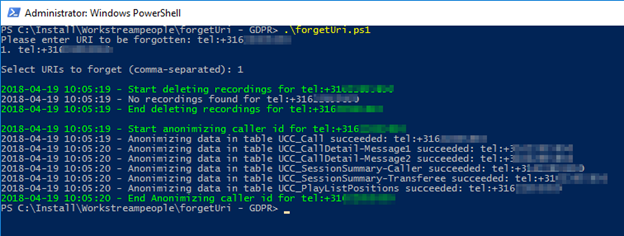How to configure GDPR (Forget Customer) script
With the GDRP script you can remove the customers info from AnywhereNow.
Configure
Request the "forgeturi - GDPR.zip" and store on a location from where you have access to the Database, SharePoint sites and the optional UNC storage.
To help the script find the proper locations, a couple parameters need to be set in the forgetUri.ps1 file
$sqlServer = 'WSP-SQLServer.contoso.com'
$sqlInstance = 'NamedInstance' #for default leave empty
$sqlDatabase = 'UCC_Database'
$sqlUsername = '' #for SQL Authentication only; for windows authentication execute script as user with permissions to the database; e.g. service account
$sqlPassword = '' #for SQL Authentication only; for windows authentication execute script as user with permissions to the database; e.g. service account
$spUsername = '' #if no SharePoint username is defined it will use current user account
$spPassword = ''
$a365ServerName = ''
$a365ConfigLocation = ''
$replaceUriWith = '**********'
$recordingLibrary = 'Recordings'
$voicemailLibrary = 'Voicemails'| Parameter | Description |
|---|---|
| $sqlServer |
The SQL Server address (Normally Hostname+Domain) |
| $sqlInstance |
Only needs to be set when a Named Instance is used. If that’s not the case, the default (MSSQL) will be used |
| $sqlDatabase |
The name of the AnywhereNow CDR Call Detail Records (CDR) are the meta data of a converstation: who talked to whom, at which time, for how long and with which identity among other things (skill, optional classification, etc) which gets stored in your SQL (analytical) database. Database |
| $sqlUsername |
If SQL Server Authentication is used, set the username here. This does not apply when you’re using the Windows Authentication method. In case of Windows Authentication, leave blanc and run the PowerShell script with the proper account. |
| $sqlPassword |
If SQL Server Authentication is used, set the password here. This does not apply when you’re using the Windows Authentication method. In case of Windows Authentication, leave blanc and run the PowerShell script with the proper account. |
| $spUsername |
Set the SharePoint username for the account which has permissions on the UCC A Unified Contact Center, or UCC, is a queue of interactions (voice, email, IM, etc.) that are handled by Agents. Each UCC has its own settings, IVR menus and Agents. Agents can belong to one or several UCCs and can have multiple skills (competencies). A UCC can be visualized as a contact center “micro service”. Customers can utilize one UCC (e.g. a global helpdesk), a few UCC’s (e.g. for each department or regional office) or hundreds of UCC’s (e.g. for each bed at a hospital). They are interconnected and can all be managed from one central location. sites (best to use a Site Collection Administrator account). If this is left blanc, the script will automatically use the credentials of the account who runs the script. |
| $spPassword |
Set the SharePoint password for the account which has permissions on the UCC sites (best to use a Site Collection Administrator account). If this is left blanc, the script will automatically use the credentials of the account who runs the script. |
| $a365ServerName |
Provide the name of the AnywhereNow server (so the script can find the Config.xml) |
| $a365ConfigLocation |
Provide the Binary path of the Config.xml The default path of this file is: C:\ProgramData\Anywhere365\Core\Service\UnifiedContactCenterService\Config.xml |
| $replaceUriWith |
The LineUri will be replaced by this (Default is **********) |
| $recordingLibrary |
The name of the SharePoint library where the recordings are stored. |
| $voicemailLibrary |
The name of the SharePoint library where the voicemails are stored. |
To run the script and start ‘forgetting’ the customers of your choosing, follow the steps below:
-
Fill in the above parameters
-
Run Windows PowerShell as administrator
Note
Make sure to use an account which has permissions on the Database and the SharePoint sites.
-
Use the cd cmdlet to browse to the path of the forgetUri.ps1 script.
-
Start the script, by typing .\forgetUri.ps1 and press enter
-
The script prompts “Please enter URI to be forgotten:”
-
Enter the phone number of the customer who wants to be forgotten. Use the E.164 The E.164 phone number format is an international (ITU) standard for dialing telephone numbers on the Public Switched Telephony Network (PSTN). Loosely formulated, only "+" and upto 15 digits (0-9) are allowed For example: +4433221100 (For number notation/display and storage see the E.123 standard) notation. (e.g. tel:+31612345678)
-
-
The script will prompt the x amount of results found in the database
- ‘Select URI’s to forget (comma-separated):
- Fill in the number, or numbers of phone numbers to wish to forget.
- E.g. 1 or 1,2,3
- Hit enter
-
The script will now start:
- to delete the found recordings
- to delete the recordings references in the database (to remove the recording link in the reports)
- to delete the voicemails
- to delete the voicemails references in the database (to remove the recording link in the reports)
- to anonymize the phone number into the value, set in $replaceUriWith (default *********)
- to anonymize the phone number on the CallSummary on the SharePoint site(s)
Examples
Example of the script

Example of modified report

Example of Call Summary list
